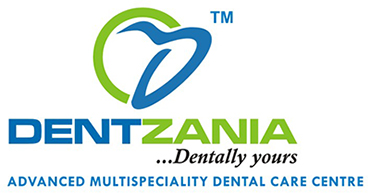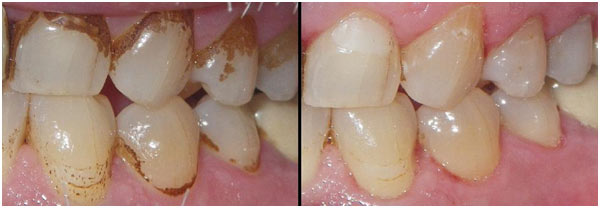Teeth Cleaning
Dental cleanings involve removing plaque (soft, sticky, bacteria infested film) and tartar (calculus) deposits that have built up on the teeth over time. Your teeth are continually bathed in saliva which contains calcium and other substances which help strengthen and protect the teeth. While this is a good thing, it also means that we tend to get a build-up of calcium deposits on the teeth. This chalky substance will eventually build up over time, like limescale in a pipe or kettle. Usually it is tooth coloured and can easily be mistaken as part of the teeth, but it also can vary from brown to black in colour.
If the scale, or calculus (tartar, as dentists like to call it) is allowed to accumulate on the teeth it will unfortunately provide the right conditions for bacteria to thrive next to the gums. The purpose of the cleaning and polishing is basically to leave the surfaces of the teeth clean and smooth so that bacteria are unable to stick to them and you have a better chance of keeping the teeth clean during your regular home care.
Regular Teeth Scaling and Polishing ensures a good oral health. This concept is well established in USA, UK and other developed countries and is strongly picking up in India as well. Doing Dental Cleaning or Teeth Cleaning is advised twice a year to remove the hard deposits of tartar & calculus which normal brushing & flossing cannot remove. This makes your teeth and gums better, cleaner & stronger.
If the scale, or calculus (tartar, as dentists like to call it) is allowed to accumulate on the teeth it will unfortunately provide the right conditions for bacteria to thrive next to the gums. The purpose of the cleaning and polishing is basically to leave the surfaces of the teeth clean and smooth so that bacteria are unable to stick to them and you have a better chance of keeping the teeth clean during your regular home care.
Regular Teeth Scaling and Polishing ensures a good oral health. This concept is well established in USA, UK and other developed countries and is strongly picking up in India as well. Doing Dental Cleaning or Teeth Cleaning is advised twice a year to remove the hard deposits of tartar & calculus which normal brushing & flossing cannot remove. This makes your teeth and gums better, cleaner & stronger.
DENTZANIA Dental assures you of a smooth and pain free cleaning experience .
Check out our packages here and get your healthy glowing smile with a spa like experience …
Check out our packages here and get your healthy glowing smile with a spa like experience …
HOW IS IT DONE ???
Ultrasonic instrument
Commonly used first is an ultrasonic instrument which uses tickling vibrations to knock larger pieces of tartar loose. It also sprays a cooling mist of water while it works to wash away debris and keep the area at a proper temperature. The device typically emits a humming or high pitched whistling sound. This may seem louder than it actually is because the sound may get amplified inside your head, just like when you put an electric toothbrush into your mouth.
The ultrasonic instrument tips are curved and rounded and are always kept in motion around the teeth. They are by no means sharp since their purpose is to knock tartar loose and not to cut into the teeth. It is best to inform the operator if the sensations are too strong or ticklish so that they can adjust the setting appropriately on the device or modify the pressure applied.
With larger deposits that have hardened on, it can take some time to remove these, just like trying to remove baked-on grime on a stove that has been left over a long time. So your cleaning may take longer than future cleanings. Imagine not cleaning a house for six months versus cleaning it every week. The six-month job is going to take longer than doing smaller weekly jobs.
Fine hand tools
Once the larger pieces of tartar are gone, the dental worker will switch to finer hand tools (called scalers and curettes in dental-speak) to remove smaller deposits and smoothen the tooth surfaces. These tools are curved and shaped to match the curves of the teeth. They allow smaller tartar deposits to be removed by carefully scraping them off with a gentle to moderate amount of pressure. Just like taking a scrubbing brush to a soiled pot, the dental worker has to get the areas clean and smooth.
Polishing
Once all the surfaces are smooth, we polish your teeth. Polishing is done using a slow speed handpiece with a soft rubber cup that spins on the end. Prophylaxis (short for prophy) paste – a special gritty toothpaste-like material – is scooped up like ice cream into the cup and spun around on the teeth to make them shiny smooth.
Ultrasonic instrument
Commonly used first is an ultrasonic instrument which uses tickling vibrations to knock larger pieces of tartar loose. It also sprays a cooling mist of water while it works to wash away debris and keep the area at a proper temperature. The device typically emits a humming or high pitched whistling sound. This may seem louder than it actually is because the sound may get amplified inside your head, just like when you put an electric toothbrush into your mouth.
The ultrasonic instrument tips are curved and rounded and are always kept in motion around the teeth. They are by no means sharp since their purpose is to knock tartar loose and not to cut into the teeth. It is best to inform the operator if the sensations are too strong or ticklish so that they can adjust the setting appropriately on the device or modify the pressure applied.
With larger deposits that have hardened on, it can take some time to remove these, just like trying to remove baked-on grime on a stove that has been left over a long time. So your cleaning may take longer than future cleanings. Imagine not cleaning a house for six months versus cleaning it every week. The six-month job is going to take longer than doing smaller weekly jobs.
Fine hand tools
Once the larger pieces of tartar are gone, the dental worker will switch to finer hand tools (called scalers and curettes in dental-speak) to remove smaller deposits and smoothen the tooth surfaces. These tools are curved and shaped to match the curves of the teeth. They allow smaller tartar deposits to be removed by carefully scraping them off with a gentle to moderate amount of pressure. Just like taking a scrubbing brush to a soiled pot, the dental worker has to get the areas clean and smooth.
Polishing
Once all the surfaces are smooth, we polish your teeth. Polishing is done using a slow speed handpiece with a soft rubber cup that spins on the end. Prophylaxis (short for prophy) paste – a special gritty toothpaste-like material – is scooped up like ice cream into the cup and spun around on the teeth to make them shiny smooth.
Contact Us For Teeth Cleaning and Polishing
If you are located in Goregaon or Malad East, Dentzania is your reasonably priced and most comfortable solution for all your teeth cleaning and polishing needs. Visit our dental clinic or call us today and consult our experienced dentist for the best solution for your requirement.



